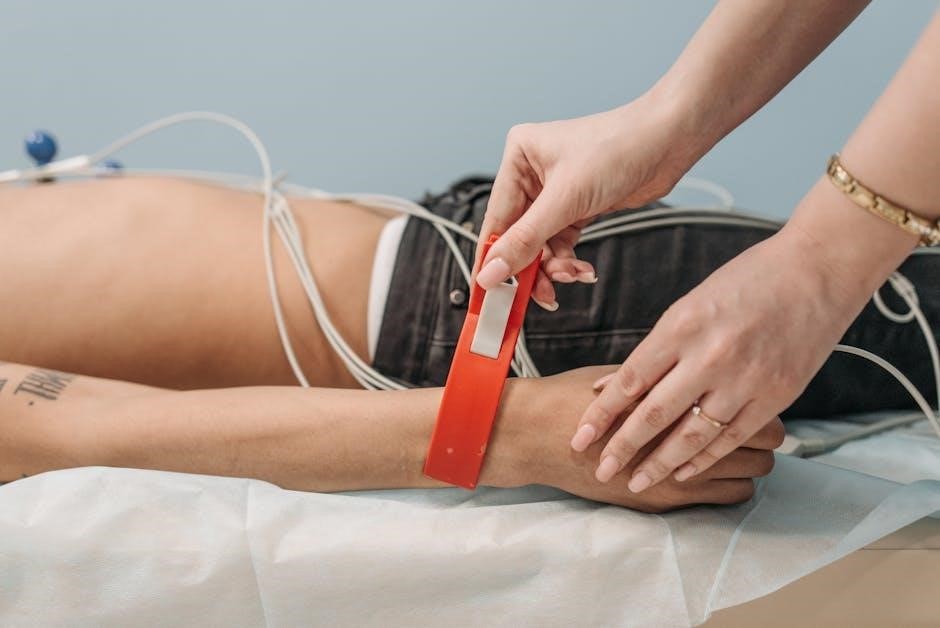A treadmill stress test is a diagnostic tool used to assess heart function under physical exertion. It helps identify abnormal heart rhythms and evaluate blood flow efficiency during exercise, providing insights into cardiovascular health and detecting potential issues like coronary artery disease.
What is a Treadmill Stress Test?
A treadmill stress test is a non-invasive diagnostic procedure that evaluates how the heart functions under physical stress, typically induced by walking on a treadmill. During the test, the patient’s heart rate, blood pressure, and electrocardiogram (ECG) are continuously monitored to assess cardiovascular health. The test is designed to detect abnormal heart rhythms, measure blood flow, and identify potential issues such as coronary artery disease. It involves increasing the intensity of exercise gradually, allowing healthcare providers to observe how the heart responds to different levels of exertion. This test is widely used to diagnose heart conditions and ensure safe exercise planning for individuals with cardiovascular concerns.
Purpose of the Test
The primary purpose of a treadmill stress test is to evaluate the heart’s response to physical exertion, helping diagnose cardiovascular conditions like coronary artery disease (CAD). It assesses how well the heart pumps blood during increased activity, identifying potential blockages or abnormalities. The test also aids in monitoring the effectiveness of treatments for existing heart conditions. Additionally, it provides insights into safe exercise levels for individuals with cardiovascular risks, ensuring personalized fitness planning. By monitoring ECG and blood pressure changes, healthcare providers can detect early signs of heart issues, enabling timely interventions and improving patient outcomes. This test is crucial for maintaining heart health and preventing complications.

Preparation for the Treadmill Stress Test
Proper preparation ensures accurate results and a smooth experience. Wear comfortable, loose-fitting clothing and sturdy walking shoes. Avoid jewelry and electronic devices that may interfere with ECG readings. Follow medication instructions provided by your healthcare provider, and refrain from eating heavy meals or caffeine for a few hours before the test. Arrive hydrated and inform your doctor about any medical conditions or concerns. Remove any accessories that could obstruct ECG placement. This preparation helps ensure the test is conducted safely and effectively, providing clear insights into your heart’s function under stress.
What to Wear and Bring
Wear loose, comfortable clothing suitable for walking, such as a t-shirt and shorts or sweatpants. Choose sturdy, non-slip walking shoes or sneakers for safety and support. Avoid wearing jewelry, especially necklaces or loose accessories, as they may interfere with ECG electrodes. Bring any prescribed medications, a list of your current medications, and your insurance cards or identification. It’s also helpful to bring a list of questions or concerns to discuss with your doctor. Stay hydrated before the test and avoid applying lotions or oils that could interfere with ECG placement. Arriving prepared ensures a smooth and efficient testing process.

Medications and Fasting Instructions
Generally, medications should be taken as prescribed unless your doctor advises otherwise. Inform your healthcare provider of all medications, including over-the-counter drugs and supplements. Fasting is not typically required for a treadmill stress test, but you may be advised to avoid heavy meals or caffeine for a few hours before the test. A light meal or snack is usually permissible to prevent nausea during exercise. Avoid consuming caffeine or nicotine, as they can interfere with heart rate and blood pressure readings. Staying hydrated is important, but avoid excessive fluid intake immediately before the test. Always follow specific instructions provided by your healthcare team to ensure accurate test results.
Removal of Jewelry and Electronics
It is essential to remove all jewelry and electronic devices before the treadmill stress test to ensure accurate ECG readings and prevent any interference. Metal items, such as necklaces, bracelets, watches, or earrings, can interfere with the ECG electrodes, leading to inaccurate results. Additionally, electronic devices like fitness trackers or smartwatches should be taken off to avoid any potential hazards or distractions during the test. Notify your healthcare provider if you have any medical alert jewelry that cannot be removed. After the test, you can put these items back on. Remember to secure your belongings safely to avoid loss during the procedure.

Procedure of the Treadmill Stress Test
The test begins with a slow walk on the treadmill, gradually increasing intensity every 2-3 minutes. Heart activity is closely monitored throughout the exercise.

Setup and ECG Placement
The setup begins with preparing the patient for the test. ECG electrodes are placed on the chest to monitor heart activity. The skin is cleaned and small pads are attached to ensure accurate readings. A blood pressure cuff is secured on the arm for regular monitoring. Patients are asked to remove any jewelry that might interfere with the ECG signals. The treadmill is calibrated, and the necessary equipment is connected. A healthcare professional explains the procedure, ensuring the patient understands the process. The setup ensures continuous monitoring of vital signs throughout the test, providing a safe and accurate assessment of heart function during exercise.
Starting the Treadmill
The treadmill begins at a slow, flat incline, typically a comfortable walking pace. Patients are instructed to hold the handrails only if needed for balance. The initial phase is designed to allow the body to adjust to the movement. The speed and incline are gradually increased every few minutes to simulate walking uphill. Heart rate and blood pressure are continuously monitored during this phase. The healthcare team observes for any signs of discomfort or abnormal heart activity. The test progresses based on the patient’s tolerance and pre-established safety protocols. This step is critical for ensuring a safe and effective assessment of cardiovascular responses to exercise.
Increasing Intensity Levels
The treadmill’s speed and incline are gradually increased every 1-2 minutes to simulate uphill walking. This progressive elevation in intensity tests the heart’s ability to adapt to physical stress. Patients are monitored closely for signs of fatigue, chest pain, or shortness of breath. Heart rate and blood pressure are recorded at each stage to assess cardiovascular response. The intensity continues to rise until a target heart rate is reached or discomfort occurs. The test is tailored to individual fitness levels, ensuring safety while maximizing diagnostic accuracy. This structured approach helps identify potential cardiac issues under controlled conditions.
Completion of the Test
The test concludes when predetermined goals are met, such as reaching maximum heart rate, or if symptoms like chest pain or dizziness occur. The treadmill is then slowed to a gentle walk to allow the heart rate to cool down. ECG and blood pressure monitoring continue during this recovery phase to ensure no post-exercise complications. Patients are observed for several minutes to monitor their recovery and overall condition. Once stable, they are informed that the test is complete, and any necessary next steps are discussed. This final phase ensures a safe transition back to resting state and provides valuable post-exercise data for analysis.

Safety and Monitoring During the Test
Continuous ECG and blood pressure monitoring ensure patient safety. Stopping criteria and emergency protocols are in place to address any adverse reactions promptly.
Continuous ECG and Blood Pressure Monitoring
During the treadmill stress test, continuous ECG monitoring tracks heart activity to detect irregular rhythms or signs of ischemia. Blood pressure is measured at regular intervals to assess cardiovascular response to exercise. This dual monitoring ensures prompt identification of potential issues, allowing immediate intervention if necessary. The ECG electrodes remain securely attached throughout the test, providing real-time data, while blood pressure cuffs inflate automatically at predetermined stages. These combined measures ensure patient safety and provide valuable diagnostic information to the healthcare team.
Stopping Criteria
The treadmill stress test is stopped immediately if certain conditions arise, prioritizing patient safety. These include severe chest pain, significant ECG changes indicating ischemia, extreme dizziness, or a sudden drop in blood pressure. Other criteria are shortness of breath that worsens, leg pain, or the patient’s request to stop due to unbearable discomfort. Monitoring technicians and physicians closely watch for these signs to ensure timely intervention. The test may also be halted if target heart rate goals are reached or if the patient cannot continue safely. Stopping criteria are in place to prevent complications and ensure the test remains safe and effective for diagnosing heart conditions.

Emergency Procedures
In case of an emergency during the treadmill stress test, immediate action is taken to ensure patient safety. If chest pain, severe dizziness, or abnormal heart rhythms occur, the test is stopped, and emergency protocols are activated. Oxygen may be administered, and a defibrillator is made ready if needed. Medical staff are trained to handle such situations, including administering medications to stabilize heart function. The patient is placed in a comfortable position and closely monitored until stable. Emergency procedures are well-established to address any complications promptly, ensuring the patient’s well-being remains the top priority throughout the test.

Post-Test Care and Instructions
After the test, patients are monitored for recovery, advised to avoid strenuous activities, and instructed to hydrate and follow up with their healthcare provider as needed.
Cooling Down and Recovery

After completing the treadmill stress test, it’s essential to cool down gradually to allow your heart rate and blood pressure to return to resting levels. This typically involves walking slowly on the treadmill for a few minutes or performing light stretching. During recovery, you’ll be monitored by healthcare professionals who will check your vital signs and ensure there are no adverse reactions. It’s recommended to avoid strenuous activities for the remainder of the day and to stay hydrated. Your doctor may also provide specific instructions based on your test results and individual health needs to ensure a safe recovery process.
Reviewing Results with the Doctor
After the treadmill stress test, your doctor will review the results with you, explaining any abnormalities detected during the exercise. This discussion will focus on how your heart responded to physical exertion, including changes in heart rate, blood pressure, and ECG readings. Your doctor will interpret whether the results are normal or if they indicate potential issues, such as coronary artery disease or irregular heart rhythms. They will also address any symptoms you experienced during the test, such as chest pain or dizziness. Based on the findings, your doctor may recommend further testing or outline a treatment plan to manage any diagnosed conditions. This conversation is crucial for understanding your heart health and next steps.
A treadmill stress test is a vital diagnostic tool for evaluating heart health, providing insights into how the cardiovascular system responds to physical exertion. It helps identify potential issues like coronary artery disease and abnormal heart rhythms, ensuring early detection and timely intervention. By monitoring ECG and blood pressure, the test offers a comprehensive assessment of cardiac function under stress. The results are crucial for guiding treatment plans and lifestyle modifications. Overall, a treadmill stress test is a safe and effective method for promoting heart health and preventing future complications. It is an essential step in maintaining cardiovascular wellness and ensuring optimal physical condition.